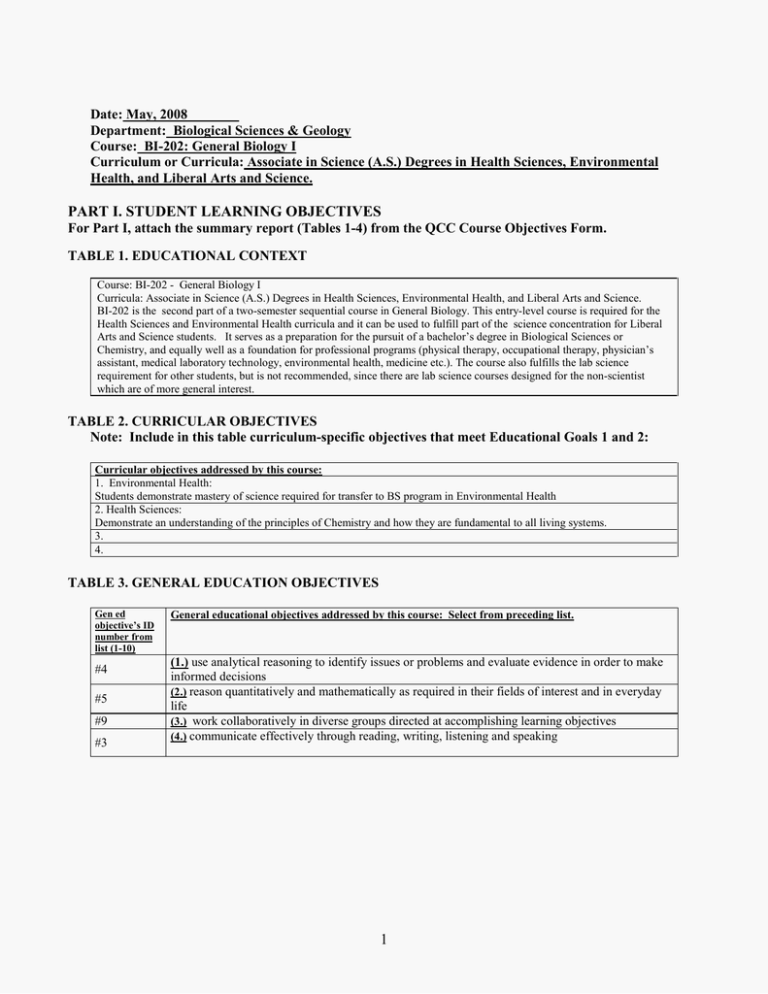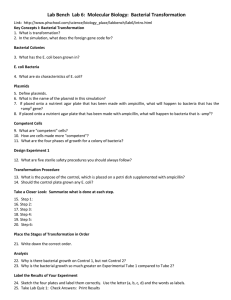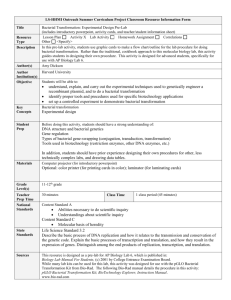Date: May, 2008 Department: Biological Sciences & Geology
advertisement

Date: May, 2008 Department: Biological Sciences & Geology Course: BI-202: General Biology I Curriculum or Curricula: Associate in Science (A.S.) Degrees in Health Sciences, Environmental Health, and Liberal Arts and Science. PART I. STUDENT LEARNING OBJECTIVES For Part I, attach the summary report (Tables 1-4) from the QCC Course Objectives Form. TABLE 1. EDUCATIONAL CONTEXT Course: BI-202 - General Biology I Curricula: Associate in Science (A.S.) Degrees in Health Sciences, Environmental Health, and Liberal Arts and Science. BI-202 is the second part of a two-semester sequential course in General Biology. This entry-level course is required for the Health Sciences and Environmental Health curricula and it can be used to fulfill part of the science concentration for Liberal Arts and Science students. It serves as a preparation for the pursuit of a bachelor’s degree in Biological Sciences or Chemistry, and equally well as a foundation for professional programs (physical therapy, occupational therapy, physician’s assistant, medical laboratory technology, environmental health, medicine etc.). The course also fulfills the lab science requirement for other students, but is not recommended, since there are lab science courses designed for the non-scientist which are of more general interest. TABLE 2. CURRICULAR OBJECTIVES Note: Include in this table curriculum-specific objectives that meet Educational Goals 1 and 2: Curricular objectives addressed by this course: 1. Environmental Health: Students demonstrate mastery of science required for transfer to BS program in Environmental Health 2. Health Sciences: Demonstrate an understanding of the principles of Chemistry and how they are fundamental to all living systems. 3. 4. TABLE 3. GENERAL EDUCATION OBJECTIVES Gen ed objective’s ID number from list (1-10) #4 #5 #9 #3 General educational objectives addressed by this course: Select from preceding list. (1.) use analytical reasoning to identify issues or problems and evaluate evidence in order to make informed decisions (2.) reason quantitatively and mathematically as required in their fields of interest and in everyday life (3.) work collaboratively in diverse groups directed at accomplishing learning objectives (4.) communicate effectively through reading, writing, listening and speaking 1 TABLE 4: COURSE OBJECTIVES AND STUDENT LEARNING OUTCOMES Course objectives Learning outcomes 1. Students will learn how changes in allelic Students will a. use stimulations to generate allelic frequencies frequencies affect the population 2. Students will use equations to analyze and interpret data. 3. Students will observe prepared slides of bacteria, and perform gram staining. 4. Students will propose a hypothesis about ecological succession in aging milk. 5. Students will observe ecological succession in aging milk. 6. Students will perform bacterial transformation and observe results of the transformation the following lab period. Students will write a lab report in scientific paper form. 7. Students will observe prepared slides and live cultures of representative protists and fungi. 8. Students will describe the distinguishing characteristics of nonvascular plants and seedless vascular plants. Students will describe the organization of cells, tissues and organs in woody and herbaceous plants. 9. Students will describe the similarities and differences in organs and body form that allow invertebrates to carry out body functions. 10. Students will describe how form and function are related in a representative vertebrate, the fetal pig. Students will a. use the Hardy-Weinberg equation to reach conclusions about population changes b. represent data in a bar graph Students will a. describe bacterial structure b. identify gram negative, gram positive and gram variable bacteria Students will a. based on knowledge and prior lab exercises students will suggest the dominant organisms in samples of aging milk. Students will a. compare and record environmental conditions in aging chocolate and plain milk. b. work in groups to analysis data and draw conclusions . Students will a. prepare bacteria cells to take up a plasmid DNA. b. use knowledge to predict the results of the transformation c. work in groups to discuss unexpected results. d. write an individual lab report Students will a. observe prepared slides using the low, intermediate, and high powers in compound microscope b. make wet mount of selected protists c. work in groups to compare alga in terms of body form and characteristics d. groups share observations with the class Students will a. examine living plants and dead trees to observe structures in the shoot, leaf and root b. work in groups to hypothesize about the function of each structure c. work in groups to prepare a chart comparing structure and function of plant cells, tissues and organs. Students will a. observe prepared slides and preserved animals b. work in groups to prepare a chart comparing excretory system, locomotion, support system, segmentation, appendages and nervous system organization. Students will a. work in pairs to dissect fetal pig and hypothesize about the function of each organ and organ system b. work in parts to create and chart comparing structure and function of organ and organ systems PART II. ASSIGNMENT DESIGN: ALIGNING OUTCOMES, ACTIVITIES, AND ASSESSMENT TOOLS TABLE 5: OBJECTIVES ADDRESSED IN ASSESSMENT ASSIGNMENT Course Objective(s) selected for assessment: (select from Table 4) Students will write a report on their bacterial transformation experiment in scientific paper format. Curricular Objective(s) selected for assessment: (select from Table 2) Students will demonstrate an understanding of the principles of Chemistry and how they are fundamental to all living systems. General Education Objective(s) addressed in this assessment: (select from Table 3) Students will reason quantitatively and mathematically as required in their fields of interest and in everyday life. 2 TABLE 6: ASSIGNMENT, OUTCOMES, ACTIVITIES, AND ASSESSMENT TOOLS Briefly describe the assignment that will be assessed: Over two Students will learn to prepare competent bacterial cells, prepare DNA, transform bacterial cells with plasmid DNA that contains a marker gene and a selection gene. Working in pairs students will streak bacteria on prepared agar plates. The following lab period, students will determine if transformation was successful and analyze any unexpected results. Students will use data to prepare an individual lab report written in scientific paper format. Desired student learning outcomes for the assignment (Students will…) Briefly describe the range of activities student will engage in for this assignment. What assessment tools will be used to measure how well students have met each learning outcome? 1. Students will learn bacterial transformation a. In lab 3, students will using sterile technique prepare competent bacterial cells, transform bacteria cells, and streak bacteria on prepared agar plates. A. Calculation of bacterial transformation efficiency 2. Students will incorporate lecture material as background information 3. Students will work in teams to conduct the experiment, record and analyze data 4. Students will report their group’s results to the class 5. Students will write and submit individual lab reports b. In lab 4, students assess the results of experiment and determine if transformation was successful. c. Working in groups students record data and report results to the class. d. Students write individual lab reports in the scientific paper format. (GEN ED OBJECTIVES # 2, 3, 7, 9) 3 B. Instructor circulates through the lab monitoring progress. C. Oral questions D. Written lab reports PART III. ASSESSMENT STANDARDS (RUBRICS) TABLE 7: ASSESSMENT STANDARDS (RUBRICS) Brief description of assignment: (Copy from Table 6 above) Over two labs, students will learn to perform a quantitative assay of enzyme activity by measuring the amount of oxygen produced by catalase reaction, complete a written PreLab assignment, work in teams to determine the optima (pH, Temperature, concentration) for the enzyme reaction, report their group’s results to the class, perform an in-class analysis of a sample lab report using a rubric and write a report on their experiment in the scientific paper format. Desired student learning outcomes from the assignment: (Copy from Column 1, Table 6 above; include Educational Goals and/or General Education Objectives addressed) Assessment measures for each learning outcome: (Copy from Column 3,Table 6 above) Standards for student performance: Describe the standards or rubrics for measuring student achievement of each outcome in the assignment. Give the percentage of the class that is expected to meet these outcomes If needed, attach copy(s) of rubrics. 1. Students will perform bacterial transformation. A. Calculation of bacterial transformation efficiency A. All students are expected to complete the table and graph, and answer the questions. 2. Student teams will conduct the experiment and analyze data B. Instructor circulates through the lab monitoring progress. B. All students are expected to follow the experimental procedures. 3. Students will report their group’s results to the class C. Oral questions C. All students are expected to answer questions regarding their experimental results. 4. 6. Students will write and submit individual lab reports (GEN ED OBJECTIVES # 2, 3, 7, 9) F. Written lab reports F. See Rubric below; Projected Outcome: 80% A, B or C BI-202 LAB REPORT RUBRIC Format (4 points) Introduction (4 points) Methods (3 points) Results (4 points) Discussion (4 points) References (1 point) Followed lab report format; size 12 font Neat and organized with no spelling/grammar errors Brief review of relevant background information Original writing (no copying lab hand out verbatim) Hypothesis clearly stated Step-by-step list or description of how experiment was performed Independent and dependent variables clearly identified Organized written summary of results Data presented in graphs/tables with appropriate labels Detailed explanation of results Conclusions follow data (no wild guesses) Discuss real world applications of the experiment Hypothesis is rejected or accepted based on the data Reasonable explanation for any errors At least two references All references are relevant and appropriate 4 Grade 100-90 89-80 79-70 69-60 Below 59 Points 18-20 15-17 12-14 9-11 0-8 PART IV. ASSESSMENT RESULTS TABLE 8: SUMMARY OF ASSESSMENT RESULTS Desired student learning outcomes: (Copy from, Column 1,Table 6 above; include Educational Goals and/or General Education Objectives addressed) 1. Students will learn bacterial transformation Student achievement: Describe the group achievement of each desired outcome and the knowledge and cognitive processes demonstrated. A. All students successfully performed the assay, completed the table and graph, and answered the questions. The following process/knowledge abilities were demonstrated: • understand and evaluate procedural knowledge • understand and evaluate factual knowledge • understand and evaluate conceptual knowledge 2. Students will incorporate lecture material as background information B. For student learning outcome, 85% of students were able to apply lecture material to the bacterial transformation experiment • understand and evaluate factual knowledge • understand and evaluate conceptual knowledge 3. Students will work in teams to conduct the experiment, record and analyze data C. All students were able to follow the experimental procedures. The following process/knowledge abilities were demonstrated: • understand and evaluate procedural knowledge • understand and evaluate factual knowledge 4. Students will report their group’s results to the class 5. Students will write and submit individual lab reports (GEN ED OBJECTIVES # 2, 3, 7, 9) D. All student groups were able to answer questions regarding their experimental results. The following process/knowledge abilities were demonstrated: • understand and evaluate procedural knowledge • understand and evaluate factual knowledge • understand and evaluate conceptual knowledge E. On learning outcome # 6, 73% of students achieved C or higher. These results very close to the projected outcome. The following process/knowledge abilities were demonstrated: • understand and evaluate procedural knowledge • understand and evaluate factual knowledge • understand and evaluate conceptual knowledge 5 TABLE 9. EVALUATION AND RESULTING ACTION PLAN. A. Analysis and interpretation of assessment results: What does this show about what and how the students learned? Students working in teams successfully performed bacterial transformation and wrote individual reports in the scientific paper format. B. Evaluation of the assessment process: What do the results suggest about how well the assignment and the assessment process worked both to help students learn and to show what they have learned? A. All students successfully performed the transformation experiment, completed appropriate calculations. Instructors monitored group progress and offered suggestions. Students who were not following the correct procedures were encouraged to repeat the experiment. B. All students were able to follow the experimental procedures. Sufficient time was allotted so that students who were not initially successful could repeat the experiment. C. All student groups were able to answer questions regarding their experimental results. Each group resented a graph of their results to the class and then answered questions during a whole class discussion. D. On the individual lab reports, 90% of students achieved C or higher. These results exceeded the projected outcome, perhaps because some of these students had experience doing lab reports in BI 201. C. Resulting action plan: Based on A and B, what changes, if any, do you anticipate making? The assignment selected for assessment in the Spring 2008 pilot, was first implemented in fall 2007. A, B, C & D No changes are needed. E. Greater emphasis will be placed on classroom management. Timely completion of the experiment depends on the students’ organizational and laboratory skills. Those who complete the exercise early can work with the instructor in assisting those having difficulty so that sufficient time can be allotted for analysis of the sample lab report. F. BI-202 instructors will meet to discuss the possibility of a pre-lab assignment. 6





